Hot Cross Buns

introduction
Let’s be honest, these gals can look pretty pedestrian—hamburger buns with a casual crosshatch of icing. In fact, before we embarked on this recipe, we wondered if hot cross buns held any gustatory relevance at all, apart from their fabled past. We discovered that they do indeed measure up to their status and reputation: these buns are as good as any good sweet roll (perhaps better because they are not so terribly sweet). They are on par with a Danish made from scratch and come close to the sublimity of authentic Dresden stollen.
Hot cross buns are ruled by subtle flavor intrigue: a warm rush of spices in a moist but not fluffy crumb, chewy citron and currants soaked in rum, butter and yeast, the can’t-put-your-finger-on-it nuance of saffron, and a sticky sugar glaze.
Baking Notes
Proper citron is no small part of the appeal of these buns. You don’t want any gooey diced Christmas leftovers. Italy Depot sells whole fruit citron, beautifully candied, and tasty enough for a snack. The Italians just “get” candied fruit. Americans just make jokes about fruitcake.
The recipe takes you through the bun-making process so that the buns are ready the same day that you start them. If you prefer, though, the dough can be made and the buns shaped the evening before. After shaping, refrigerate the loosely covered buns overnight (up to 8 hours). The following morning, remove the baking sheet from the refrigerator, lift off the plastic wrap, and allow the buns to stand at room temperature for 1 hour while you heat the oven and pizza stone. Starting at step 6, below, make the crosses, bake, and glaze the buns.
equipment mise en place
For this recipe you, will need a digital scale, a small saucepan, a small bowl, a fine-mesh strainer, a stand mixer with a flat beater and dough hook attachment, a rubber spatula, a large mixing bowl, parchment paper, a rolling pin (optional), a bench knife, a pizza stone, a baking sheet (or two, if yours are thin), a whisk, a pastry bag and small plain tip (or a parchment paper piping cone), a digital instant-read thermometer, a pastry brush, and a wire rack.
-
for the buns:
-
1.2ounces (¼ cup) currants
-
1.7ounces (⅓ cup) diced citron
-
1ounce (2 tablespoons) Meyers’s dark rum
-
7ounces (¾ cup plus 2 tablespoons) whole milk
-
Medium pinch of saffron threads
-
14ounces (about 3 cups) Anson Mills French Mediterranean Bread Flour, plus additional for shaping the buns
-
1½teaspoons instant yeast
-
3.5ounces (7 tablespoons) unsalted European-style butter, room temperature
-
1.6ounces (3 tablespoons plus 2 teaspoons) sugar
-
½teaspoon fine sea salt
-
½teaspoon ground cardamom
-
½teaspoon ground nutmeg
-
½teaspoon ground cinnamon
-
1large egg (not greater in weight than 2 ounces out of the shell), lightly beaten
-
-
for the crosses:
-
1.6ounces (⅓ cup) unbleached all-purpose flour
-
1.8ounces (3 ½ tablespoon plus 2 teaspoons) water, plus additional if needed
-
-
for the glaze:
-
2ounces (¼ cup plus 2 teaspoons) sugar
-
1.5ounces (3 tablespoons) water
-
-
Make the buns: Turn the currants, citron, and rum into a small saucepan and stir to combine. Heat the mixture over low heat, stirring, until warmed through (fig. 1.1). Transfer to a small bowl, cover, and let the fruit absorb the rum for at least a few hours or up to overnight.
-
Warm the milk in a small saucepan over medium heat until tiny bubbles appear around the edges. Add the saffron and swirl the pan (fig. 2.1). Remove from the heat and let cool to the temperature of a hot bath, about 100 degrees. Sprinkle the yeast over the surface of the milk, let stand for a minute or two, and swirl the pan until the yeast dissolves.
-
Pour the milk mixture through a fine-mesh strainer into the bowl of a standing mixer, pressing on the saffron threads to extract their tincture. Dump 9½ ounces (about 2 cups) of the flour into the bowl. Mix with the dough hook on medium speed, pausing to draw the flour into the liquid ingredients with a rubber spatula if necessary, until the dough is smooth, strong, and elastic (fig. 3.1), about 5 minutes. Transfer the dough to a large mixing bowl, cover with plastic wrap, and allow the dough to rise at room temperature until doubled in size and the imprint of a finger remains on the surface of the dough when the dough is lightly pressed, 1 to 1½ hours.
-
While the dough is rising, turn the butter, sugar, salt, and spices into the bowl of the standing mixer and beat with the flat beater until light and fluffy, about 3 minutes, scraping down the bowl once or twice. Add the egg and mix to combine, about 1 minute, scraping down the bowl as needed. With the mixer running on low speed, add the fermented dough piece by piece, scraping down the bowl a couple of times. Add the remaining flour (4.5 ounces, or about 1 cup) and mix on medium speed until the dough gathers together. Swap the dough hook for the flat beater and knead on low speed until the dough is smooth, strong, and elastic (fig. 4.1), about 10 minutes. Detach the bowl from the mixer, cover tightly with plastic wrap, and let the dough ferment at room temperature until doubled in size and the imprint of a finger remains on the surface of the dough when the dough is lightly pressed (fig. 4.2), 1 to 1½ hours.
-
Adjust the oven racks to the lower and middle positions and heat the oven to 425 degrees. Line a baking sheet with parchment paper. Lightly sprinkle flour over the work surface. Gently deflate the dough and turn it onto the surface. Sprinkle the dough lightly with flour and stretch or roll it into a rectangle measuring about 12 by 16 inches. Sprinkle the macerated fruit evenly over the rectangle (fig. 5.1) and roll up the dough like a carpet. Fold both ends of the roll to meet in the middle (fig. 5.2), and then turn seam side down. Using a bench knife, portion the dough into fifteen 2-ounce pieces. On an unfloured area of the work surface and without using additional flour, form each piece into a tight ball by cupping your hand over the piece and dragging it against the work surface in a circular motion (fig. 5.3). Place the balls on the prepared baking sheet, spacing them evenly (fig. 5.4), and cover loosely with plastic wrap. Let rest for 15 minutes.
-
Make the crosses: While the buns are resting, fit a small pastry bag with a very small plain tip or make a parchment paper piping cone if you know how. Turn the flour into a small bowl and whisk well to break up any lumps. Pour in the water and whisk until the mixture forms a stretchy but pipeable paste (fig. 6.1); add more water drop by drop if needed to achieve the proper consistency. Spoon the paste into the pastry bag or parchment cone.
-
After the buns have rested, lift off the plastic wrap. Pipe crosses onto each bun (fig. 7.1). Allow the buns to rise, uncovered, until soft and yielding, about 15 minutes more.
-
If the baking sheet that the buns are on is thin, set it on a second baking sheet for insulation, then bake the buns until nicely risen, golden brown, and the centers register 190 to 195 degrees on a digital instant-read thermometer, about 15 minutes, rotating the baking sheet halfway through the baking.
-
Make the glaze: Shortly before the buns are finished, combine the sugar and water in a small saucepan and bring to a simmer over medium heat, stirring to dissolve the sugar. Simmer until the mixture is syrupy and registers 224 degrees on a digital instant-read thermometer, about 10 minutes. Remove from the heat, cover, and set aside until needed.
-
When the buns come out the oven, let cool on the baking sheet for 5 minutes. Transfer the buns to a wire rack and set the rack over the now-empty baking sheet (fig. 10.1). Brush the buns with hot syrup, coating the sides as well as the top of each (fig. 10.2). Let cool until barely warm or to room temperature and serve. The buns are also excellent split open, oven-toasted, and buttered.
-
-
1.1
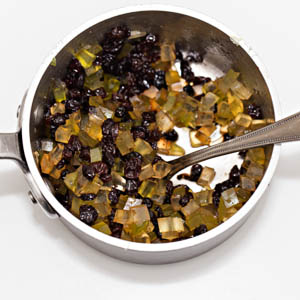
-
-
-
2.1
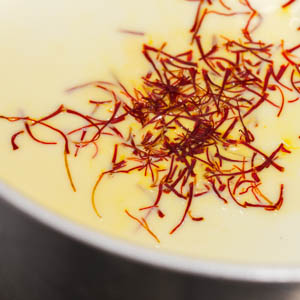
-
-
-
3.1
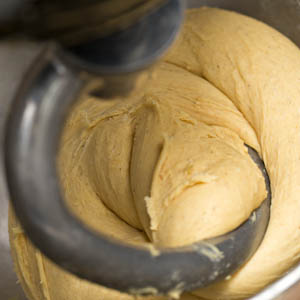
-
-
-
4.1
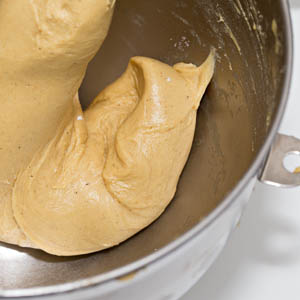
-
4.2
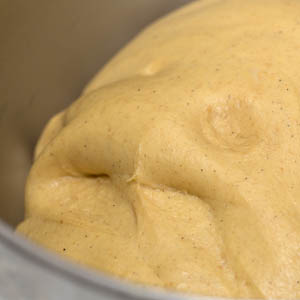
-
-
-
5.1
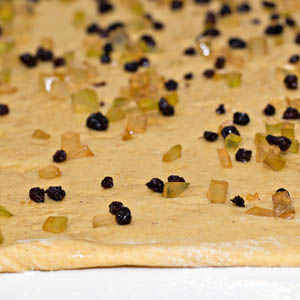
-
5.2
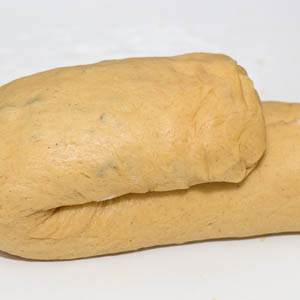
-
5.3
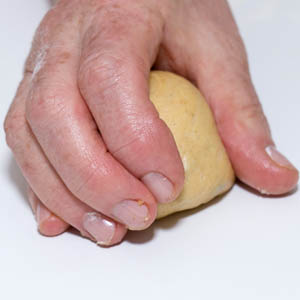
-
5.4
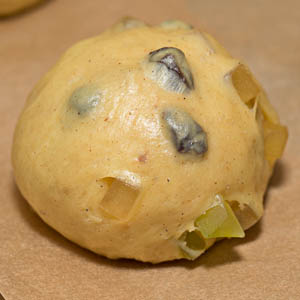
-
-
-
6.1
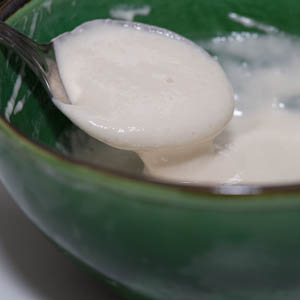
-
-
-
7.1
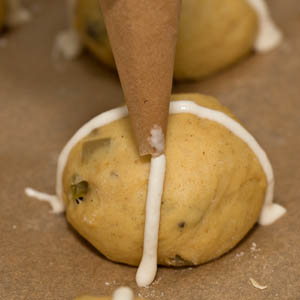
-
-
-
10.1
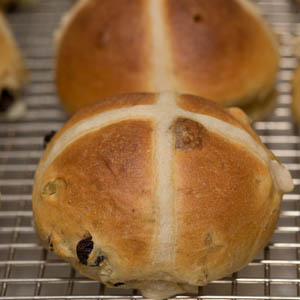
-
10.2
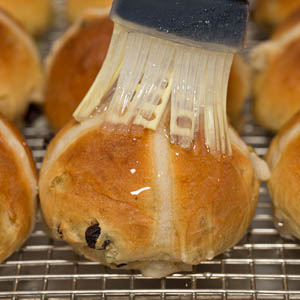
-